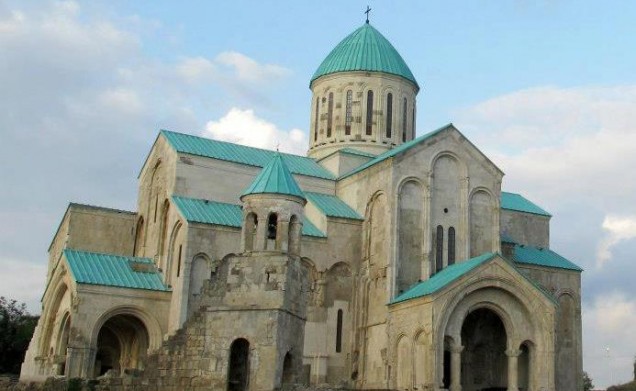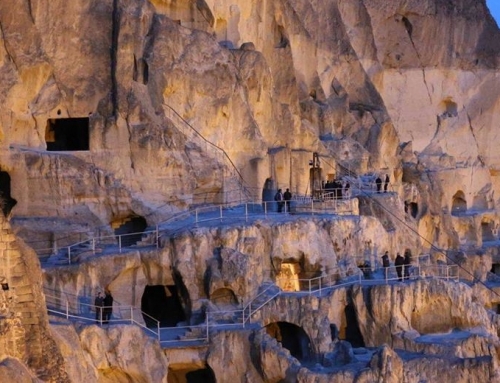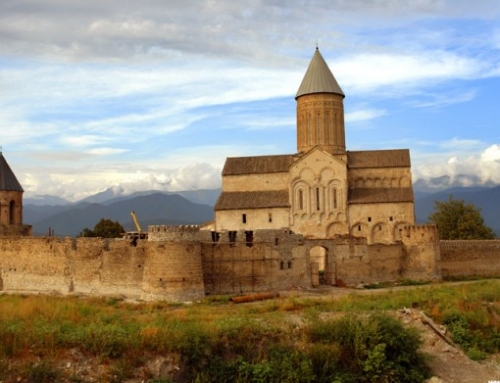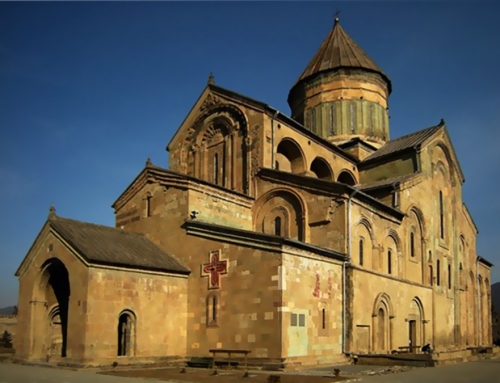The Cathedral of the Dormition, or the Kutaisi Cathedral, more commonly known as Bagrati Cathedral is the 11th century cathedral church in the city of Kutaisi, the region of Imereti, Georgia. The cathedral is regarded as a masterpiece in the history of medieval Georgian architecture. The conservation and restoration works, as well as archaeological studies, which began in 1952, are still underway. In 1994, the Bagrati Cathedral, together with the Gelati Monastery, was included in the UNESCO World Heritage Site list as a single entity. In 2001, the cathedral was restored to the Georgian Orthodox Church. Bagrati attracts many pilgrims and tourists.
The Cathedral of King Bagrat in Kutaisi ranks among the best monuments of Georgian architecture. The constructions began in the last quarter of the 10th century and ended in 1003, during the time of flourishing feudal economy and culture in Georgia. The acropolis rose on a hill above the right bank of the Rioni River.
From the 10th to the 13th century, Kutaisi was a prosperous city. The town, located 236km (146 miles) west of Tbilisi serves as the capital of Imereti and the second largest city in Georgia, lying on both sides of the Rioni River. According to some scholars during the late Bronze Age (1300 BC) Kutaisi was the capital of King Aeetes, Medea’s father who possessed the Golden Fleece.
The first king of a unified Georgia, Bagrat III (975-1014) commissioned the cathedral which stood intact for seven hundred years. Even in its present ruined state, you cannot but feel the grandeur and nobility of the structure and sense of power and wonder.
The Cathedral of Bagrat is a triconch with protruding sidearms to form the cross. Several years after the completion of the cathedral, a three-story residential tower was added to the left side of the west façade which probably served as the king’s quarters or as the residence of the local archbishop. After the completion of the cathedral a richly ornamented portico with open arches was added to the southwest sides. Two decades later, this concept was repeated in front of the entryways on the west and south sides. These later embellishments were marked by elaborate, deeply incised stone carvings. Mythical animals, human faces, and sometimes human faces on animal bodies predominate here, usually intertwined with rich leaf motifs.
Russian ambassadors who visited the church in the middle of the 17th century reported that the interior was covered with mosaics. Remnants of the design of the floor – broad circles interspersed with inlays of black, white, and red are still visible at the eastern end of the building.
The cathedral was sacked and destroyed by the Ottoman troops in 1691. The incident caused the cupola and ceiling to collapse leaving the cathedral in its present state. Since 1951 Georgian restorers have been working on the site.
In 1994, the Bagrati Cathedral, together with the Gelati Monastery, was included in the UNESCO World Heritage Site list as a single entity. In 2001, the cathedral was restored to the Georgian Orthodox Church. It is now of limited use for worship services, but attracts many pilgrims and tourists. Being one of the main tourist attractions Bagrati Cathedral is frequently used as a symbol of the whole city of Kutaisi.






